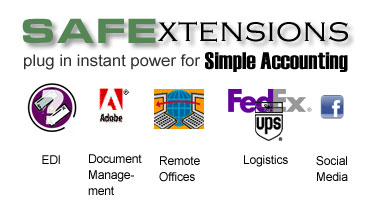This data entry screen is used to set up the fields which are used in processing sales and accounts receivable. Here is where you enter the starting invoice and purchase order numbers you will be using, and also supplementary messages which can be printed on your invoices, and statements. These can be overridden at print time, but remain in the system, as the default for each run.
ORDER DEFAULTS
| ORDER ID NUMBERING | Mixed/Employee Uses a combination of the Employee ID for the order, plus a unique number. |
| MIXED/CUSTOMER | Uses a combination of the orders Customer ID and a unique number. |
| NUMBER BY TRANSACTION ID | Uses the same Sales Orders Transaction ID for each Sales Order ID. |
| NUMBER BY ORDER ID | Uses the NEXT SALES ORDER ID field (described below) to generate a sequential number for each Sales Order ID. This has the advantage of allowing you to determine the starting number of the ORDER ID.
You may also set up a user-defined formula for creating Order IDs if you have Simple Accounting Security Extensions. This makes other schemes possible such as: JH070023 (the twenty third order processed for salesperson Jim Hamilton during July of 2000.) |
| NEXT ORDER ID | Enter the next number to use for ORDER ID in each Sales Order.
This will only function if you have the Number By Order option selected above. |
| TAX FREIGHT REVENUE? | Check here if you want shipping to be included when the program calculates the tax for each invoice. |
| TAX ART WORK REVENUE? | Check here if you want revenue from art work to be taxed on customer invoices. |
| Order Lead Time | This field determines the number of days from the Sales Order Date to automatically enter in the Ship Date field on new orders. For example, if you set this field to fifteen (15) then an order entered on January 1, 1997 will automatically default to a Ship Date of January 16,1997. |
| DEFAULT ORDER FOB | Sets the default header field for FOB in Sales Orders. |
| DEFAULT SHIP VIA | Sets the default header field for SHIP VIA in Sales Orders. |
| DEFAULT ORDER STATUS | Sets the default header field for ORDER STATUS in Sales Orders. Enter either ‘O’ to make all transactions default to ‘Order’ status, or ‘Q’ to set all new orders to ‘Quote’ status. |
| MARK UP FREIGHT? | Sets the default header field for FREIGHT MARKUP for Customers. Enter either:
Yes Freight cost passed on to customer plus a No Freight cost passed on to customer with no mark up. Include Freight cost not passed on to customer.
|
| DEFAULT SALES TAX ID | Set the default sales tax ID for new customers. |
| DEFAULT TERMS ID | Set the default terms ID for new customers and vendors. |
| Cash or Accrual Sales | This field determines how sales commissions are calculated on reports for each sales order. Valid choices are:
A Accrual. Commissions are calculated based on printed invoices using the invoice date. C Cash. Commissions are calculated based on paid invoices using the date the invoice was paid in full. So if the invoice was paid on three separate partial payments, it will appear on the commission report on the date the final payment was received. |
| PROFIT CALCULATION | This field determines how profit is calculated and displayed for each sales order. Valid choices are:
O Only the gross profit of items sold. F Include Freight Revenue but not Artwork. A Include Freight Revenue and also Artwork Revenue. |
| PROFIT PERCENTAGE | Determines the default profit percentage for all new Product Types. Each product type in turn determines the default mark up for all products assigned to it. When you enter a new product, the Unit Price defaults to the Unit Cost you have entered plus the Product Types profit percentage. |
COMMISSION CALCULATIONS
| CALCULATION METHOD | This field determines how the sales commission due field is calculated on the Sales Commission Detail Report. |
| C | Use the commission percentage field for each Customer ID. |
| E | Use the commission percentage field for each Employee ID. |
| P | Use the commission percentage field for each Product ID. |
| S | Use the commission percentage field for each Status ID. |
| T | Use the commission percentage field for each Terms ID. |
| V | Use the commission percentage field for each Vendor ID
The commission uses the PROFIT CALCULATION METHOD and the CASH OR ACCRUAL SALES METHOD fields to derive the proper amount. |
| SALES REP ASSUMES ALL LOSS ON UNPROFITABLE SALES | This field determines how commissions are calculated on invoices for which there was a loss (no profit). If checked, the commission due on a loss invoice is equal to the total of the loss. If not checked, the commission due is simply the percentage of the loss, calculated in the same manner as profitable invoices using the COMMISSION CALCULATION field. |
| HANDLING FEE | Enter any fee which is immediately deducted from the gross profit on a every sale before commission is calculated. In other words, if the gross profit on an order is $100.00 and you enter $10.00 into this field, then the commission for the sales order will be calculated on the remaining $90.00. |
| AGING PERCENTAGE | Enter a percentage here to deduct from the sales commission on orders which are more than 30 days past due for payment from the customer. The deduction is made as a percentage of the gross profit on unpaid orders. In other words, if the gross profit on an unpaid order is $100.00 and you enter 1% into this field, then $1.00 would be deducted from the salespersons commissions during the period on the Sales Commission Report. |
INVOICE, STATEMENT & A/R DEFAULTS
| INVOICE MESSAGE | The default message which can be displayed at the bottom of each invoice. |
| CREDIT MEMO MESSAGE | The default message which can be displayed at the bottom of each credit memo, that is: all invoices with credit (negative) totals. |
| RFQ MESSAGE | The default message to appear at the bottom of Vendor Request for Quotes. |
| STATEMENT MESSAGE | This message appears at the bottom of customer statements when the balance is current. |
| 1ST, 2ND, 3RD, 4TH, 5TH AGING PERIOD MESSAGES | These messages print at the bottom of customer statements when the account is past due. Which message prints is determined by the maximum number of days past due.
If the oldest unpaid invoice for a customer is 33 days, and your Aging Period #2 begins at 30 days, then PAST DUE MESSAGE #2 would print at the bottom of their statement. These messages will only print on your forms if your form definition includes this capability. |
| NEXT INVOICE # | This sets the next invoice number for use in sales orders. All invoices and credits are assigned the next unique number in ascending sequence. |
| DEFAULT INVOICE DATE TO… | Normally Simple Accounting assigns the current date to a customer invoice when it is first printed. However, you can use thisdrop-down-list to default the invoice date to the Ship Date field in the sales order header.
If the user enters an invoice date manually into the order before invoicing, this date remains the sales orders invoice date regardless of this option boxs setting. |
| FINANCE CHARGE% | The finance charge applied to any invoice that becomes overdue. Leave this as zero to prevent automatic posting of finance charges in the Apply Customer Finance Charges menu. |
| LAST DATE GENERATED | The last date when finance charges were automatically calculated and posted to each customers account in the Apply Customer Finance Charges menu. |
| REORDER NOTICE SCRIPT | This field selects the script that contains the default body text for your reorder notices. |
| AUTOMATIC PER ORDER HANDLING FEE | |
| AMOUNT | Enter any fee which is automatically added as a line item to all sales orders. |
| PRODUCT ID | Enter the Product ID of the line item to be added onto each order as a handling fee. |
Aging Periods
In Simple Accounting there are six user-definable aging periods. These four fields define the length of each of these periods as described below based on the number of days an invoice would be considered past due.
| The FIRST AGING PERIOD | always refers to Current Invoices; invoices which are not past their due date. This due date is defined by the terms of that invoice. |
| The 2ND AGING PERIOD | includes invoices which are no longer current, but which are past due a number of days less than the number indicated in the 3RD AGING PERIOD. |
| The 3RD AGING PERIOD | includes invoices which are past due a number of days equal to or greater than the 2ND AGING PERIOD but which are past due less than the number indicated in the 4TH AGING PERIOD. |
| The 4TH AGING PERIOD period | includes invoices which are past due a number of days equal to or greater than the 4TH AGING PERIOD and which are past due less than the number indicated in 5TH AGING PERIOD. |
| The 5TH AGING PERIOD | includes invoices which are past due a number of days equal to or greater than the 5TH AGING PERIOD and which are past due less than the number indicated in 6TH AGING PERIOD. |
| The SIXTH AGING PERIOD | includes invoices which are past due a number of days equal to or greater than the 6TH AGING PERIOD.
Assuming that you sell on Net 30 days. If the age of open invoices, in days, are:
Then the corresponding days past due are:
So enter the following into these fields: PRD 3 PRD 4 PRD 5 PRD 6 N/A N/A 30 60 90 120 |
Order Entry
Settings for Sales Orders
| FREIGHT COST MARKUP FORMULA | This field is used to automate marking up the freight cost to determine the sell price. For example, you could have a freight cost of over $20 automatically marked up by 10%, while a cost of under $20 could remain at cost or have $2 automatically added. |
| ART COST MARKUP FORMULA | This field works in the same manner as the Freight Cost Markup. |
| ORDER ID FORMULA | This field can be used to enter a formula for determining your own Order ID system.
Setting the next Sales Order ID to a particular number: 1. 2. 3. 4. 5. |
| RELEASE ID FORMULA | This field can be used to enter a formula for determining your own Release IDs. |
| SHIP IN NAME OF FORMULA | Allows you to select a formula for the default text in the Ship In Name Of field during Sales Order entry. By default, this field will contain your company name, however, you could create a formula which printed a salespersons name,. or a d.b.a. company name if you are processing orders for a third-party distributor. |
| WARNING NOTES FORMULA | This field is independent of the Customer Warning notes within the Customer Master in SAFE. This field can be used to set up additional warning notes for ALL customers such as a warning to appear if a customer has open invoices older than 60 Days. |
| DISABLE SALES TAX OVERRIDE? | Disables the ability to override the taxability of a line item in Sales Order entry by hiding the Taxable? checkbox. |
| DISABLE FREIGHT OVERRIDE? | Disables the ability to override or change the freight sell amount in Sales Order entry. |
| SAVE VENDOR NOTES TO PRODUCT? | Checking this box enables saving vendor notes entered on a Sales Order back to the product master. |
| BACK ORDER UNDER RUN | Enter the under run percentage to allow before a back order is automatically generated. Set to zero to disable automatic back orders. |
| AUTOMATICALLY ASSIGN CURRENTLY LOGGED IN USER AS EMPLOYEE ID #2 ON ORDERS? | If your company has customer service reps (CSRs), this field automatically assigns the CSR as Employee ID#2 on new sales orders.
If you enable this feature, you should probably disable Allow Split Commissions in the A/R tab so that commissions are not incorrectly assigned to Employee ID #2. |
| ALLOW NON-INVOICED ORDERS TO BE DELETED? | Checking this box allows non-invoiced orders to be deleted. Leaving the box unchecked forces the order to be voided thereby leaving a record of who entered as well as who voided the order but does not leave any sales history. |
| REMEMBER LAST SHIP TO? | Checking this box enables copying the last Ship To information including Sales Tax ID and Ship Via into subsequent line items on a Sales Order. |
| REMEMBER LAST SHIP FROM? | Checking this box enables copying the last Ship From information into subsequent line items on a Sales Order. |
| CALCULATE USAGE AS EACH ORDER IS SAVED/PRINTED? | Check this box to update usage totals as each order is saved and/or invoiced. |
| GET VENDOR NOTES ON RELEASES? | Vendor Notes normally default to each Sales Order line item. Uncheck this box if you do not wish to assign these notes to the Vendor Notes box when a Sales Order Line Item type is set to ‘Release’. |
A/R
| AGING PERIOD FOR PRINTING ONLY PAST DUE STATEMENTS | Select the statement aging period for which Past Due statements will print. |
| HIDE DISCOUNTED TOTAL ON AGING REPORT? | Check this box to hide the Discounted Total column on the Aging Report. |
| ALLOW PAYMENTS TO POST FROM OTHER CUSTOMERS? | Normally, when entering customer payments, you may only post a payment to open invoices assigned to the Customer ID from which the payment is received. Checking this box enables you to accept payments for one customer but made by another customer. |
| AUTOMATICALLY POST FREIGHT TO A/P FROM COGS VENDOR? | Automatically post freight costs to primary vendor’s invoice if no Freight Invoice or Vendor is entered? (Defaults to Yes) |
| SPLIT COMMISSIONS BETWEEN SALES PEOPLE ON REPORTS? | Check this box to enable split commissions between multiple Employee IDs on a Sales Order. |
| AUTO-POPULATE CUSTOMER PAYMENTS? | Checking this box enables automatic entry of line items for open invoices when the user begins entering a customer payment. Open invoices are entered from oldest open item forward, as can be accommodated by the amount of the payment received. |
| CUSTOMER FINANCE CHARGE GRACE PERIOD: | Enter the number of days an invoice is past due before customers are assessed a finance charge. For example, if your terms are Net 10 but you do not wish to assess a finance charge until an invoice is 30 days old, you would enter ’20’ here.
If you have a Grace Period, the starting date used to calculate the Finance Charge remains the date the invoice was due. Your terms are Net 10. But you have a Grace Period set to 30 Days. This means that the invoice will not trigger a finance charge until it is forty one (41) days old. Customer ABC has two open invoices: One which is 18 days old and one which is 55 days old. The first invoice will not be subject to Finance Charges since it falls within the Grace Period. However the second invoice will and the Finance Charge will be calculated based on 45 days. |
 The Freight Mark Up Formula is set in
The Freight Mark Up Formula is set in 


